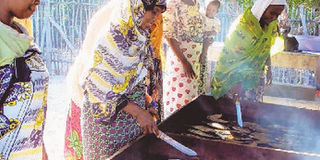Kilns help fish mongers net more cash

Women from Gazi put final touches on fish being dried ready for sale. MAZERA NDURYA I NATION
What you need to know:
- Driers have locked out middlemen ensuring handsome returns for women at the Coast
With babies strapped to their backs women take every detail to ensure that everything goes according to plan. Smoke oozes gingerly from one of the fish smoking kilns at Gazi Village in Msambweni District while the mothers continue to stoke the fires.
This is one of the means that have been developed to help fishing communities preserve their catch and cut down on huge loses made after harvesting from the ocean.
Mrs Mwanatumu Omar, one of the officials of Mpaji ni Mungu Women Group in Gazi, said the new technology has changed fortunes for the women who are mainly mongers buying and selling fried fish on a day to day basis.
“We normally buy fish directly from fishermen, check its quality according to the training we have received from the Kenya Marine and Fisheries Research Institute (KMFRI), wash and then gut them before putting them on the kilns to dry.
“In order to add value to the catch that would otherwise go to waste especially when there is bumper catch, we put additives to the fish before drying them after which they fetch more money,” she said during an interview.
The kiln strategically located a few metres from fish landing site is made up of cement with some racks and can take up to 250 kilogrammes of fish at one go.
Mrs Omar said they buy fish at between Sh100 and Sh120 per kilogramme but once dried, one piece of the fillet costs about Sh100 in the local market making their profits much higher than if they had bought, fried and sold the fish straight from the waters.
She said the fish have a longer shelf life adding that when properly prepared, it can last up to three months. Mrs Omar said they package the smoked and dried fish in special packets that do not contain any moisture.
Through the group network, the women have seen increased incomes and managed to lock out middlemen.
The solar drier and the smoking kiln have more than one uses.
“We do not waste anything because when the fish season is over, we turn to drying other products like fruits and other stuff like cassava making us busy throughout the year,” the women leader said.
The smoking drier is a modified one and much cheaper than the solar drier which is also being used at Gazi for demonstration to teach the communities how to preserve fish.
A KMFRI researcher Cyprian Odoli said the solar drier is more expensive with a complete unit costing about Sh370,000.
“The most important thing now is that the community has taken up the technology seriously because it has seen its value. This technology has made work much easier because it only takes two days to prepare and dry the fish ready for the market. Once production has gone up, communities that use this technology should move a step further on standardisation,” he said.
Women in Gazi have seen the great potential available with the drier and are looking into ways of making it even better, bring the Kenya Bureau of Standards on board, package to international standards and sell to supermarkets in the country.
According to KMFRI which came up with the technology, fishermen have been losing up to about 40 per cent of their catch due to lack of proper storage facilities given that most are poor and cannot afford to buy freezers.
KMFRI executive director Johnson Kazungu said the problem is not unique to the Coast but even in the inland waters such as Lakes Victoria and Turkana where proper post-harvest systems would help in reducing loses and increase incomes to the communities.
Mr Kazungu said they have set focus on Lake Turkana because it has the greatest potential.
“The prospects for Lake Turkana are great given that some trucks all the way from the Democratic Republic of Congo (DRC) have been going there to get dried fish.
“The biggest challenge in Turkana is poor infrastructure that has scared investors but once that is fixed, this is the place that will give this country huge revenue,” he said.
He said the drying technology is catching up in Kipini in Tana Delta and Moa in Lamu.




